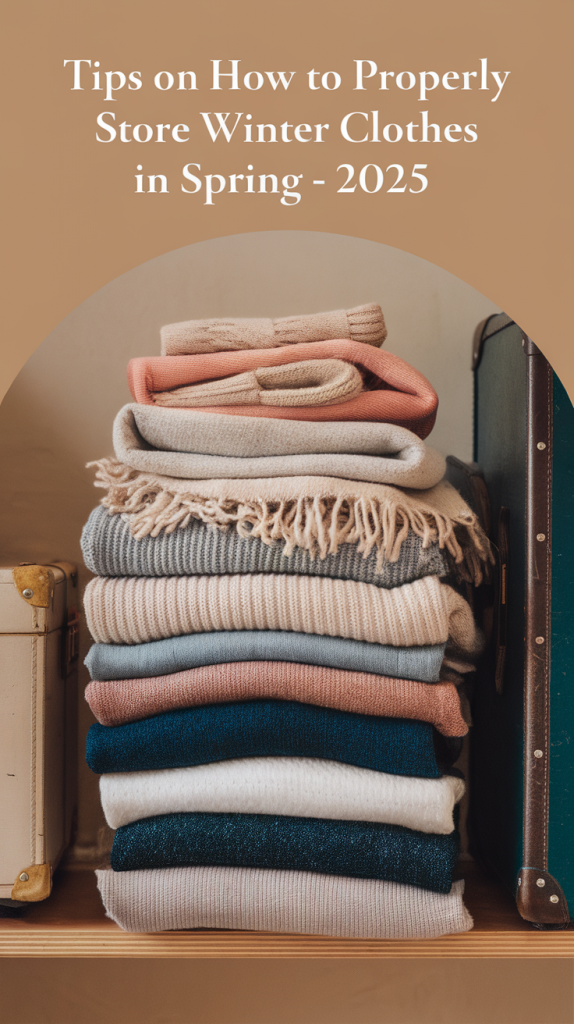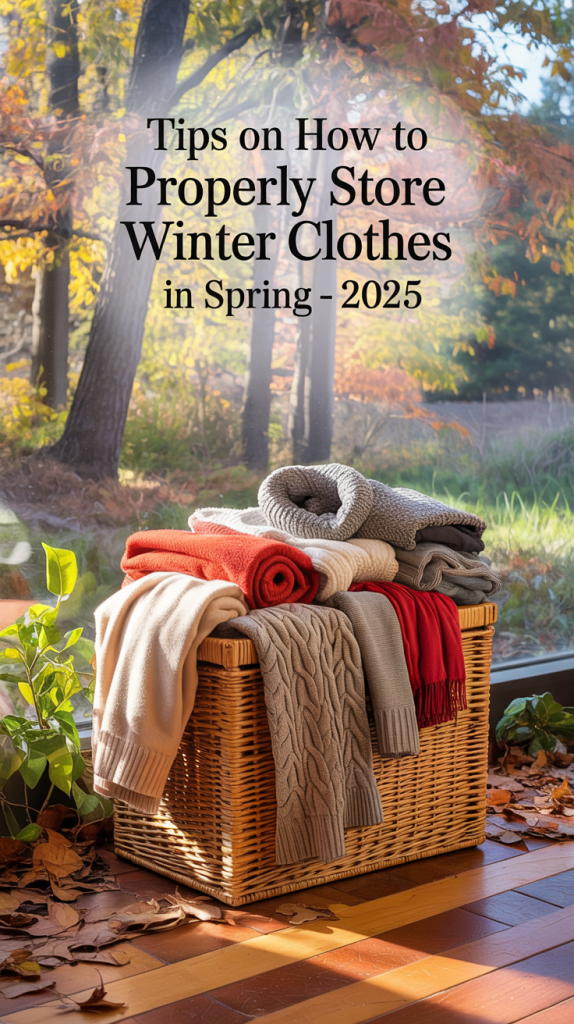How to Properly Store Winter Clothes in Spring – Tips for 2025

Do you realize that improper storage is among the top causes why winter garments age quicker? Sweaters lose their shape. Down jackets flatten. Wool retains moisture and by the following season smells musty. And we’ve all experienced this, trying to wear last year’s coat only to recognize it’s ruined—stinky, wrinkled, or worse, damaged.
Spring season 2025 is the ideal opportunity to evaluate your approach towards storage. In this guide, we explain how to store winter clothes in a way that they can be worn at a moment’s notice when the temperature drops again. From efficient methods of organizing and freeing up space in cramped apartments to innovative eco-friendly product suggestions, we’ve got you covered.
👤 Who is this article for?
Everyone who has in their possession a coat, a sweater, a pair of boots, gloves, or a scarf and want to maintain it in impeccable condition until next winter.

🧤 Why Proper Winter Clothes Storage Matters in 2025
It is not only about keeping things tidy but ensuring that the fabric is in good condition, saving money, and showing consideration towards nature.
As of 2025, the rise of sustainable fashion has led to purchasing fewer items, instead, we focus on quality.
Your cashmere, wool, and technical coats must sustain the season. Bad folding can result in mold mildew, a breakdown of fabric, pests, and inflexible permanant folds. The worst part? Most of these problems are easily averted.
Why work harder when you could work smarter?
Step-by-step directions for how to properly pack and preserve winter clothing follow this sentence.
As stated above, begin with cleaning everything.
Cleaning ‘set aside’ clothes should be done because food stains, dirt, and spent oils make fabric cling to unwanted attention from pests purple-tinged stains that will be impossible to get rid of later.
With regards to the jacket, unless under specific washing machine conditions, many jackets are machine washable, air drying along with tumble drier balls or fluffers is the way to go if you want to maintain freshness.
A big bonus step would be remembering to always put clothes that are damp slightly into the clothing world of fungi, mold. Fungi loves moisture.
Prep and Sort for Long-Term Storage
You don’t need to store everything. Identify which pieces you’ll use on chilly spring nights (like light knitwear or puffer vests) and store the rest.
✔️ Apply moth repellents like cedar blocks or lavender sachets. Avoid toxic chemicals, especially if you have kids or pets.
✔️ De-pill sweaters and inspect for damage—storage is a good moment to plan repairs.
✔️ Fold knitwear, but hang structured coats using padded hangers.
📌 Mini Checklist: Winter Storage Prep
-
Cleaned and dried
-
Sorted by type/seasonality
-
Repaired and de-pilled
-
Moth-repellent added
Choose the Right Storage Containers
Let’s talk boxes, bins, and bags.
| Storage Option | Pros | Cons |
|---|---|---|
| Vacuum-sealed bags | Space-saving, dust-proof | Can flatten natural fibers |
| Fabric bins with lids | Breathable, stackable, stylish | May allow dust if not sealed |
| Plastic containers | Waterproof, durable | Less breathable = moisture risk |
| Garment bags | Best for coats & delicate items | Take up more space |
🧠 Avoid: Grocery bags, thin plastic wrap, or anything that traps moisture.
👢 Tips for Storing Different Types of Winter Items
Each category of clothing requires a slightly different approach.
🧥 Coats and Jackets
Heavy outerwear, especially wool or down-filled, should be hung upright to maintain shape. Use wide, padded hangers to avoid shoulder dents.
💡 Don’t store coats in tight plastic—it traps moisture and can lead to mildew. Opt for cotton garment bags or breathable covers.
🧣 Sweaters, Scarves, and Knitwear
Breathe free boxes help in keeping heavier knits on the bottom organizing breather them. One can take acid free tissue between folds to avoid creases.
🧠 Tip: Avoid overstacking. Garments containing knitwear ought to be allowed to have some left room (or space) to breathe.

🥾 Boots and Winter Shoes
Shoes for winter need particular attention:
-
Make sure the the leather or suede is cleaned on the soles and treated before storing out for use.
-
Boot shapers or rolled-up magazines help in keeping the form.
-
Should be Cotton shoe bags or boxes with labels that are kept in a single.
Every Box Should Have packets that absorb moisture don’t forget to add it.
🧤 Gloves, Hats, and Accessories
These items may be small changing an entire mail might be alluring but throwing it all in a desk drawer can be so tempting for some people.
To do instead:
-
Use pouches zip or dividers that go in drawers.
-
Put labels so that they can be found easily next year.
-
Classify by materials such as leather, wool, and synthetic.
❌ Avoid These Storage Mistakes For The Year 2025
So many of us fall into the same traps. Here is what you need to pay attention to:
-
Storing dirty clothes’ → invites pests and enables stains.
-
Using non breathable plastic → Breeds mold and mildew.
-
Cramming items together → Causes damage to pier fabrics.
-
Storing in damp places → can be basements or garages put at risk for dehumidifiers.
Table: Common Mistakes and Smart Solutions
| Mistake | Better Option |
|---|---|
| Plastic bags from stores | Breathable fabric bins |
| Untreated Boots | Clean + Leather Conditioner |
| No labels | Labeled boxes for quick ID |
| Tossing items together | Organizers by category |
🏢 Small Apartment? Here’s How to Save Space
Living in a studio or city apartment? You’ve got options!
- Under-bed storage: bins or Rolling drawers.
-
Vertical closets: Stack containers and use labeled bins.
-
Vacuum bags: great for duvets and puffers—but not for wool!
And don’t forget: coat hooks and over-door racks are your friends.
🤔 What’s your go-to space saving hack?

🌿Eco-friendly storage tools for try in 2025
The future of fashion is sustainable – and so is storage.
-
Cedar hangers & blocks: Natural moth deterrent with a fresh scent.
-
Organic cotton garment bags: Permits air exchange and is multifunctional.
-
Compostable storage bags: A new trend “in fashion” for containing storage plastic bins.
-
Refillable lavender satchels: No waste allows fragrant lavender scented things.
🧠 Tip: Take a look at eco-friendly stores in your area. Brands like Package Free and Grove Collaborative offer these.
✅ Quick Recap: Your Winter Clothes Storage Checklist
Here’s your no-frills guide:
-
Clean everything first.
-
Sort by type and frequency of use.
-
Repair and de-pill.
-
Use breathable storage containers.
-
Add moth repellents (cedar or lavender)
-
Leave moisture traps and plastic bags.
-
Label boxes clearly.
- Cool, dry area should be used.
-
Check mid-season if storage check is required.
-
Next winter, your future self will thank you.
💬 What is Your Secret for Storing Winter Items?
The stage is now all yours!
Are there any hacks to store boots or keep sweaters fluffy?
Put your images, suggestions, or ideas in the comments and let us create the ultimate guide on
winter storage in 2025.
📲 Remember to send this article to friends and roommates who need help with better storage.

📸 Recommended Images for WordPress
-
Hero Image: closet or breathable fabric boxes in light colors that are well arranged.
-
Infographic: A step by step infographic featuring storage procedures or do’s vs don’ts.
-
Chart/Table: A comparison of storage containers.
-
Mini-gallery: Properly folded sweaters, boot storage setup, cedar accessories.
-
YouTube embed (optional): How to store winter coats or DIY lavender sachets.




